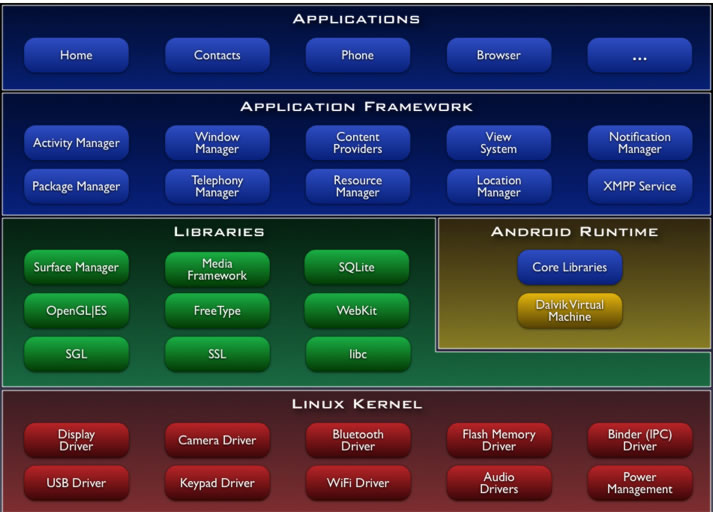Android - An Open Handset Alliance Project
What is Android?
Android is a software stack for mobile devices that includes an operating system,
middleware and key applications. This early look at the
Android SDK [ http://code.google.com/android/download.html ] provides the tools and APIs necessary to begin developing applications
on the Android platform using the Java programming language.
Features
- Application framework enabling reuse and replacement of components
- Dalvik virtual machine optimized for mobile devices
- Integrated browser based on the open source
WebKit [ http://webkit.org/ ]
engine
- Optimized graphics powered by a custom 2D graphics library; 3D graphics
based on the OpenGL ES 1.0 specification (hardware acceleration optional)
- SQLite for structured data storage
- Media support for common audio, video, and still image formats (MPEG4, H.264,
MP3, AAC, AMR, JPG, PNG, GIF)
- GSM Telephony (hardware dependent)
- Bluetooth, EDGE, 3G, and WiFi (hardware dependent)
- Camera, GPS, compass, and accelerometer (hardware dependent)
- Rich development environment including a device emulator, tools for debugging,
memory and performance profiling, and a plugin for the Eclipse IDE
Android Architecture
The following diagram shows the major components of the Android operating system.
Each section is described in more detail below.

Applications
Android will ship with a set of core applications including an email client,
SMS program, calendar, maps, browser, contacts, and others. All applications are
written using the Java programming language.
Application Framework
Developers have full access to the same framework APIs used by the core applications.
The application architecture is designed to simplify the reuse of components; any
application can publish its capabilities and any other application may then make
use of those capabilities (subject to security constraints enforced by the framework).
This same mechanism allows components to be replaced by the user.
Underlying all applications is a set of services and systems, including:
- A rich and extensible set of
Views [ http://code.google.com/android/reference/view-gallery.html ] that can be used to build an application, including lists, grids,
text boxes, buttons, and even an embeddable web browser
-
Content Providers [
http://code.google.com/android/devel/data/contentproviders.html ] that enable applications to access data from other applications
(such as Contacts), or to share their own data
- A
Resource Manager [ http://code.google.com/android/devel/resources-i18n.html
], providing access to non-code resources such as localized
strings, graphics, and layout files
- A
Notification Manager [
http://code.google.com/android/reference/android/app/NotificationManager.html
] that enables all applications to display custom alerts
in the status bar
- An
Activity Manager [
http://code.google.com/android/reference/android/app/Activity.html ] that manages the lifecycle of applications and provides
a common navigation backstack
For more details and a walkthrough of an application, see
Writing an Android Application [
http://code.google.com/android/intro/tutorial.html ].
Libraries
Android includes a set of C/C++ libraries used by various components of the Android
system. These capabilities are exposed to developers through the Android application
framework. Some of the core libraries are listed below:
- System C library - a BSD-derived implementation of the standard C system
library (libc), tuned for embedded Linux-based devices
- Media Libraries - based on PacketVideo's OpenCORE; the libraries support
playback and recording of many popular audio and video formats, as well as static
image files, including MPEG4, H.264, MP3, AAC, AMR, JPG, and PNG
- Surface Manager - manages access to the display subsystem and seamlessly
composites 2D and 3D graphic layers from multiple applications
- LibWebCore - a modern web browser engine which powers both the Android browser
and an embeddable web view
- SGL - the underlying 2D graphics engine
- 3D libraries - an implementation based on OpenGL ES 1.0 APIs; the libraries
use either hardware 3D acceleration (where available) or the included, highly
optimized 3D software rasterizer
- FreeType - bitmap and vector font rendering
- SQLite - a powerful and lightweight relational database engine available
to all applications
Android Runtime
Android includes a set of core libraries that provides most of the functionality
available in the core libraries of the Java programming language.
Every Android application runs in its own process, with its own instance of the
Dalvik virtual machine. Dalvik has been written so that a device can run multiple
VMs efficiently. The Dalvik VM executes files in the Dalvik Executable (.dex) format
which is optimized for minimal memory footprint. The VM is register-based, and runs
classes compiled by a Java language compiler that have been transformed into the
.dex format by the included "dx" tool.
The Dalvik VM relies on the Linux kernel for underlying functionality such as
threading and low-level memory management.
Linux Kernel
Android relies on Linux version 2.6 for core system services such as security,
memory management, process management, network stack, and driver model. The kernel
also acts as an abstraction layer between the hardware and the rest of the software
stack.
12 Nov 2007 14:37
Copyright 2007

